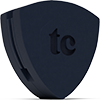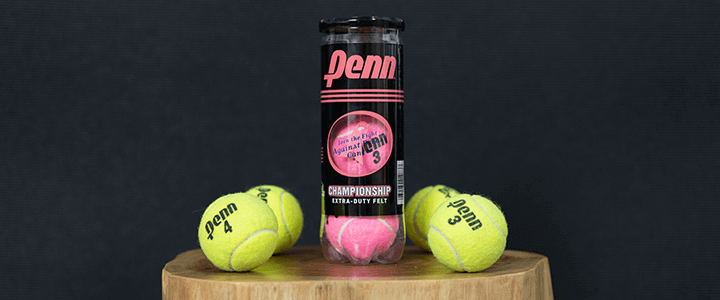Check out my custom vibration dampener
Colored Tennis Balls
History, Types & Uses
We hope you love this article. Just so you know, TennisCompanion may collect a small share of sales from the links on this page to help keep this site running. Learn more.
Over the years, the color of tennis balls has evolved to help increase visibility, and as we’ll cover in this guide, their hue has been a matter of substantial debate: are they yellow or green?
Distinct colors also help distinguish varying levels of the game for kids ten and under who are learning how to play tennis.
Beyond their role on the court, colored tennis balls have various practical yet somewhat unexpected uses, from laundry to chairs and walkers and popular toys for pets.
This guide covers it all, including our top picks for various colored tennis balls based on their intended use.
| Kind | Colors | Category |
| Penn Youth Foam Balls | Yellow/Red | Kids (4-6 yr) |
| Penn Youth Felt Red | Yellow/Red | Kids (6-8 yr) |
| Penn Youth Felt Orange | Yellow/Orange | Kids (7-10 yr) |
| Penn Youth Felt Green | Yellow/Green | Kids (11-12 yr) |
| Zanies Puppy Pride | Purple, blue & more | Dogs |
| Top Glides Precut | Black, brown, & more | Walkers/Chairs |
| Penn Championship | Pink | For a Cause |
| Wilson Championship | White | Laundry |
Article Contents
Click below to jump to a section
Tap below to jump to a section
History of Ball Colors
What Color Are Tennis Balls?
Types of Tennis Balls
Colors for Kids
Colors for Dogs
Colors for Chairs & Walkers
Pink Balls for a Cause
White Balls for Laundry
Wrapping Up
New to TennisCompanion?
Create a free account and explore my latest videos below
The History of Tennis Ball Colors
To the surprise of many new players, tennis balls were originally black or white, with the color of the court’s background dictating which ball was more practical for use.
In 1972 the International Tennis Federation introduced optic yellow tennis balls to help aid with visibility on TV, which led to a fairly rapid change across most tournaments in professional tennis.
Interestingly enough, the black and white color of tennis balls hadn’t been much of an issue before color TVs became mainstream, which made it more difficult for spectators to see the ball.
However, steeped in tradition, Wimbledon resisted the change up until 1986 when they made the transition to yellow tennis balls.
These days, it’s hard to imagine tennis balls not being yellow.
What Color Are Tennis Balls?
In February of 2018, a surprising debate emerged from a Twitter poll asking if you would describe a tennis ball as yellow, green, or other.
It turns out that of the thousands of people who responded, the majority believed tennis balls were green, which left many people puzzled.
According to the official rules of tennis from the ITF, the only approved colors for tennis balls to this day is white or yellow.
Furthermore, cans of balls by prominent tennis brands like Wilson printed optic yellow directly on the can, as is the case with Wilson’s seen below.

Shortly after the debate emerged, a fan asked Roger Federer what color tennis balls were, and he said yellow.
With all that proof, we can close the case, right?
Unfortunately, it’s not that easy, and there will always be people on both sides of the fence due to each person’s perception, lighting, and standard labels we apply to the fuzzy objects we call tennis balls.
If you ask us, we say yellow ;)
Types of Tennis Balls
Before we jump into some of the more common uses for colored tennis balls, let’s touch on the different kinds of tennis balls available.
Pressurized vs. Pressureless
In professional and competitive settings, tennis balls are pressurized with a gas such as nitrogen, which helps give them their bounce.
However, as you’ve likely experienced, the pressure wears off rather quickly, and you eventually have to replace the ball. As a result, even unopened cans of pressurized tennis balls have a shelf life. Typically, pressurized tennis balls come in pressurized cans as a set of three.
Pressureless balls, on the other hand, are not pressurized usually don’t come in a can and instead are often sold by the bag or in a bin. Since they’re not pressurized, they last longer on and off the court, and they’re most commonly used for practice and with ball machines because of their higher durability.
High altitude
Per the International Tennis Federation, above 4,000 feet, you’re playing at “high altitude,” where the lower air pressure results in more bounce from your standard pressurized tennis ball.
High-altitude tennis balls feature slightly less pressure to achieve a more typical bounce that you’d expect from a tennis ball.
Regular Duty vs. Extra Duty
Regular duty tennis balls feature a softer felt for use on clay or indoor courts. As you play with them, the thinner felt also helps prevent them from absorbing less dirt and debris.
Extra duty balls, on the other hand, have a thicker felt cover that helps them hold up better on outdoor hard courts.
Men’s vs. Women’s
Although it may come as a surprise, some professional tennis tournaments like the US Open use slightly different tennis balls for the men’s and women’s tournaments.
The balls are identical in every way except the felt for the men’s tennis balls is heavier than the women. The result is a slightly faster ball on the women’s side and slower for the men.
At the US Open, you can distinguish one ball from the other by the color ink printed on the tennis ball – red for women’s and black for men.
Giant Tennis Balls
You won’t find oversized tennis balls used on the court, but they make great souvenirs at some of the world’s most prestigious tournaments.
They also make a great tennis gift idea. For example, you might buy on for your coach at the end of a season and have all the players sign it.
Giant tennis balls can also make great toys for kids and pets.
Pre-Cut for Chairs and Walkers
If you plan to use tennis balls for chairs or walkers, pre-cut tennis balls make the installation process safer and easier.
These days you’ll find a wide variety of pre-cut tennis balls in an assortment of colors and prints.
Colored Tennis Balls for Kids
Kids tennis racquets have been around for several years. However, it wasn’t until recently that the United States Tennis Association (USTA) stepped in to adapt the rest of the learning experience for kids.
Back in 2010, the USTA introduced 10 and Under Tennis, which features smaller courts, lower nets, and specialized tennis balls to help make learning the game easier.
The earliest stage tennis balls are foam and don’t feature any pressure, and the remaining kids’ tennis balls contain less pressure than your standard tennis ball to help slow the game down and make practice and skill-building easier.
Kids’ tennis balls are color-coded and categorized as follows.
Red: Stage 1
Stage 3 tennis balls are color-coded red and yellow for kids age 4-6. These are the largest and made of soft foam for kids ages 4-6 who use a 23-inch tennis racquet and smaller 36′ x 18′ court, which is 2′ 9″ high.
Our favorite pick for Red Stage 1 tennis balls are from Penn’s youth foam tennis balls.
Red: Stage 2
Next up, for Stage 2, you have red and yellow tennis balls that feature the same construction as your standard tennis ball, but they’re 15% larger and 25% of the compression. The racquet, court, and net size are the same as Stage 1, but the age range will be 6-8 years old.
Penn’s red felt youth tennis balls are our top pick for Red Stage 2.
Orange
Kids ages 7-10 will start using orange and yellow tennis balls, which are standard size with 50% of the compression of your typical tennis ball.
Racquet sizes will range from 23-25 inches, and the court size will increase to 60′ x 21′ for singles and 60′ x 27′ for doubles. The net height increases to the standard size of 3′ at the center and 3′ 6″ at the posts.
Our pick for the best orange and yellow kids tennis balls are the Penn youth orange felt balls.
Green
Last but not least, green and yellow tennis balls are for children ages 11-12 who are using 25-27 inch racquets and playing on a full-sized court.
Green and yellow tennis balls are the same size as regular tennis balls but feature slightly less compression at 75% of standard yellow.
Our favorite for green tennis balls are Penn’s green youth felt balls.
Penn is one of the top-selling tennis ball manufacturers. With their kids’ tennis balls, you get that same renowned quality that you’d expect from standard yellow tennis balls for kids.
In addition to the color-coding to help distinguish them, they also list the size of the court that’s appropriate for use. The USTA approves all kids’ tennis balls from Penn for use in the 10 and Under Tennis Program.
Colored Balls for Dogs
Although your dog may not be overly concerned with the color of their favorite tennis ball, it’s still fun to purchase a variety of brightly colored tennis balls for our furry friends.
Practical reasons to consider colored tennis balls for your pup include distinguishing them from your good tennis balls for the court, keeping tabs on them at a busy dog park, and making them easier to spot on a grassy field.
Our favorites colored tennis balls for dogs are from Zanies. In addition to coming in a rainbow of six fun colors, each ball has a paw print decal and the Zanies logo. Plus, they’re made of durable rubber and felt that some dogs may still be able to tear to pieces but make for fun toys that are perfect for playing catch.
If you have a smaller dog, you might check out their mini tennis balls, which also come in an assortment of multi-colored balls.
Colored Tennis Balls for Chairs and Walkers
For years, old or retired tennis balls have made a surprisingly great addition to chairs and walkers.
By cutting a tennis ball and placing it on the feet of a chair or walker, you can protect floors and reduce the harsh noise that can accompany either as they’re dragged or pushed along the ground.
Of course, your standard tennis ball will do the trick, but they can be difficult and dangerous to cut, so you can find pre-cut tennis balls that also come in a variety of colors, including blue, orange, pink-brown, black, yellow, and grey.
Our top pick for colored tennis balls that you can use for walkers and chars are Top Glides pre-cut tennis balls, which come in a variety of colors and even a red and blue American flag novelty design. They’re easy to install and designed to glide smoothly over the floor.
If you have a lot of walkers or chairs that need to be protected, you might want to consider buying the tennis balls in bulk.
Pink Tennis Balls for a Cause
The vast majority fo tennis balls designed for on-court play are going to be your standard yellow, but Penn introduced their can of pink tennis balls that are not only fun to play with but support a great cause too.
The pink tennis balls support the fight against breast cancer, with 15 cents per can of balls donated to research.
As you’d expect, these balls come with the usual quality and performance players expect from Penn, which has earned them their place as the official ball of USTA leagues and approval by the ITF.
White Tennis Balls for Laundry
Did you know tennis balls can make your laundry dry faster?
Whether you’re doing a standard load or drying heavier items like blankets and coats, throwing in a few tennis balls can reduce wrinkles and static and prevent items from bunching up, so they dry faster.
It’s a simple laundry hack that’s been around for years but mostly flown under the radar, just make sure the tennis balls you use are new or clean to avoid unintentionally making your clean laundry dirty again.
Our pick for the best tennis balls for laundry is white Wilson Championship Anniversary addition tennis balls. Of course, they aren’t explicitly designed for laundry and work great on the court but serve the purpose of laundry well.
Wrapping Up
Beyond the court, colored tennis balls serve a variety of different purposes. From pet toys to walkers and chairs and even laundry, there’s an assortment of colors to serve every purpose.
As a parent, it’s important to find the right color tennis ball for your child’s age range to help promote their success and enjoyment of the game. Hopefully, our guide has helped point you in the right direction.
As for the exact color of regular tennis balls, we’ll leave that up to you. What color do you think they are? We’d love to hear in the comments below.
Home > Gear > Accessories > Colored Tennis Balls
Play Better Tennis
Improve your game alongside our community of tennis players
Why join?
Discussion Boards
Join the conversation with other members of the community.
5 Point Friday
Read our weekly recap of the 5 most interesting things we dig up in tennis.



Leave a Reply
Want to join the discussion?Feel free to contribute!